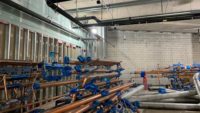There are some amazing builders in our industry that I’ve been fortunate to work with — men and women who lead teams with great success while at the same time building great leaders beside them. It’s an attitude driven by doing all the things the right way, along with a care for people and clients that brings great results. We should begin every project with the end in mind — a safe and successful execution, proper installations, great functionality, team building and client satisfaction. We interview, get pumped up for the wins, teams get assembled, projects are delivered with high expectations and then we take it to the next opportunity. Let’s zoom in on where the system installations represent a successful project and what we leave behind.
In the kickoff phase, many projects today are modeled by the construction team using BIM coordination and clash detection. This greatly impacts and improves the constructability of the systems being installed and also identifies conflicts early. Modeling also drives prefabrication opportunities if done early enough. There is a lot of variability in the level of coordination in design, depending on the amount of progress the design team has made when the modeling effort begins.
It’s not uncommon to find MEP system layouts referred to as “diagrammatic” with general routing shown. This is done in the interest of clarity, but there should also be an expectation that systems will fit where MEP is generally shown and paired with the architectural and structural system designs (design layouts are the cost basis for system installations and pricing). When we are modeling systems in space and above ceilings, top priority should be placed on service clearances for equipment and accessibility to equipment and components that need to be accessible due to building codes, maintenance, and replacement activities. My frequent input to modeling includes:
- Avoid installing equipment and hydronic or domestic piping above ceilings with specialty finishes and at higher elevations, such as hotel and hospital lobby areas. Access is difficult, and condensation or smalls leaks over time can be a problem;
- Keep HVAC and plumbing equipment within three feet of the ceiling elevation for maintenance and service access;
- Install control valves and auxiliary pumps serving roof-mounted equipment above the ceiling and in accessible locations to simplify connections and wiring to these devices and testing/balancing work (it also frees up space in pipe chases);
- Install system components that don’t need regular access at higher elevations (main distribution piping and larger ducts);
- Include hangers and seismic supports in the model so that these are not obstructions to access panels on equipment when the work is installed in the field; and
- Include all systems in the model that need to be coordinated in the space with MEP systems including fire sprinkler, BMS controls, structural wall supports and building framing at priority walls.
After a completed model is assembled and signed off, we typically submit the individual trades’ reflected work for shop drawing review. This is an opportunity for the designer to verify final layouts and compliance with the design. It’s not uncommon that some shifting or relocations are required. When this is significant and systems have changed position dramatically, it can negatively impact system performance, specifically with pumps or fans and how they’ve been sized and selected. There may be costs to consider, potentially positive and negative in nature.
Modeling has a significant effect on setting up good installations, but these systems have to work and perform like we want when it’s time to bring them online, even when all the “stuff fits.” Pipe slope, air management, service access, routine cleaning and testing needs, and equipment replacement (one day down the road) should always be part of the conversation. Having your foremen, superintendent, project manager and BIM detailers who have sufficient knowledge and understanding of system operation included in the modeling effort is key.
Installing systems like they are shown in the model then becomes the focus. Having systems that “fit” in the computer model ahead of actual installation has been a game changer in our industry (I do remember working with vellum sheets and light tables!). Once the trade partners have made sufficient progress with installations, we are doing “first work in place” inspections. Mock-ups are also popular in our industry for client and design team approval. These evaluations help flush out issues that weren’t anticipated. It also sets up the bigger breadth of the project installations for success and less rework. Rework can be a killer when it comes to schedule, progress and profitability.
Modeling has a significant effect on setting up good installations, but these systems have to work and perform like we want when it’s time to bring them online, even when all the “stuff fits.” Pipe slope, air management, service access, routine cleaning and testing needs, and equipment replacement (one day down the road) should always be part of the conversation. Having your foremen, superintendent, project manager and BIM detailers who have sufficient knowledge and understanding of system operation included in the modeling effort is key. We shouldn’t ever lose sight of how and where we’re installing equipment and system components so that our facility engineers and maintenance teams can perform routine service and repairs.
I often refer to the ASHRAE handbook for life cycle information on mechanical equipment and components when comparing system options and ownership costs for clients. With service life data that extends over decades, it’s obvious (to me) that the approach to serviceability and how we build and turn over mechanical and plumbing systems to the end user is critical to the longevity and reliability of what we’re installing. I like to think about “feeling good” about what we turn over in a project and leave behind for our owner and facilities teams — this is the kind of thing that follows you in business, you know.
Today’s systems are more complicated and sophisticated than they were 10 or 20 years ago, and great MEP engineers and contractors are more important than ever to design and build projects that perform and endure the test of time!




